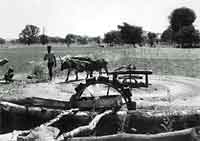Ground realities
 the pre-eminent position attained by groundwater in the field of irrigation in India must be duly recognised. It accounts for well above 50 per cent of the total irrigated area. Water management policies should aim at bolstering and upgrading the Central Groundwater Board and its research programmes. The state groundwater boards should also be empowered.
the pre-eminent position attained by groundwater in the field of irrigation in India must be duly recognised. It accounts for well above 50 per cent of the total irrigated area. Water management policies should aim at bolstering and upgrading the Central Groundwater Board and its research programmes. The state groundwater boards should also be empowered.
The track record of the minor surface-water sector has been worse than the lack of productivity exhibited by the major and medium sectors. According to land-use statistics published by the ministry of agriculture, the net area served by this sector registered a decline from 8.2 million ha (mha) in 1961 to 6.8 mha in 1989. The downslide occurred despite the fact that around Rs 6,000 crore was invested in the sector during the intervening 28 years. The main cause for this debacle is the premature siltation of reservoirs, which, being much smaller than those of the major and medium sectors, go out of operation much faster. In this context, I would like to propose a change in the very nomenclature in use. Irrigation schemes should not, as at present, be classified as either
Related Content
- Coal vs renewables investment report
- Evaluating readiness for renewable energy adoption in India: a multi-state survey of industrial and residential power consumers
- Employing a systems thinking approach in climate risk assessments
- Immersive research for safer sanitation in Bihar and Maharashtra, India
- African shifts: the Africa climate mobility report- addressing climate-forced migration & displacement
- Reconciling conservation and global biodiversity goals with community land rights in Asia
